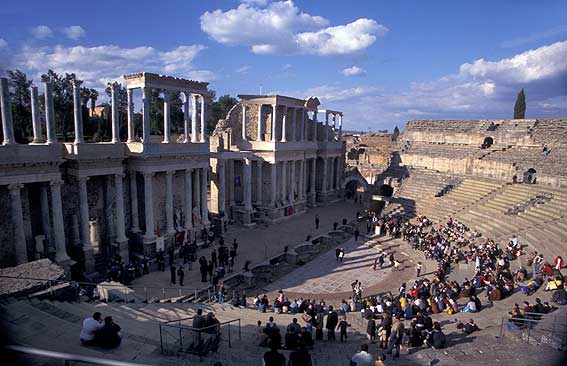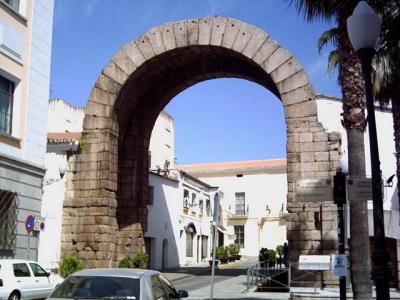EMERITA AUGUSTA (MÉRIDA A HISTORICAL ROMAN CITY)
Discover this historic city where the Romans left their mark with the trips of www.spainsouthwest.com
The Archaeological Ensemble of Mérida is one of the largest and most
extensive archaeological sites in Spain. Mainly of Emerita Augusta, ancient capital of Lusitania (current city of Mérida). It was declared a World Heritage Site by UNESCO in 1993.

Roman Theatre
The theatre was built from 15 to 16 BC and dedicated by the consul Marcus Vipsanius Agrippa. It was renovated in the late 1st or early 2nd century AD, possibly by the emperor Trajan, and again between 330 and 340 during Constantine's reign, when a walkway and new decorative elements were added. With the advent of Christianity as Rome's sole state religion, theatrical performances were officially declared immoral: the theatre was abandoned and most of its fabric was covered with earth, leaving only its upper tiers of seats (summa cavea). In Spanish tradition, these were known as "The Seven Chairs" in which several Moorish kings held court to decide the fate of the city.

Roman Amphitheatre
The amphitheatre was dedicated in 8 BC, for use in gladiatorial contests and staged beast-hunts. It has an elliptical arena, surrounded by tiered seating for 15,000 spectators. The seating is divided according to the requirements of Augustan ideology, with the lowest seats reserved for the highest status spectators. Only this lowest tier survives. When the games fell into disuse, the amphitheatre's upper tiers were quarried for stone, for use in new buildings nearby.

Roman Circus
The circus of Emerita Augusta was built some time around 20 BC, and was in use for many years before its dedication some thirty years later, probably during the reign of Augustus' successor, Tiberius. It was sited outside the city walls, alongside the road that connected Emeritus in Corduba (Córdoba) with Toletum (Toledo). The arena plan was of elongated U-shape, with one end semicircular and the other flattened. A lengthwise spina formed a central divide within, to provide a continuous trackway for two-horse and four-horse chariot racing. The track was surrounded by ground level cellae, with tiered stands above. At some 400m long and 100m wide, the Circus was the city's largest building, and could seat about 30,000 spectators – the city's entire population, more or less. Like most circuses throughout the Roman Empire, Merida's circus resembled a much scaled-down version of Rome's Circus Maximus.
Roman bridge over the Guadiana
The situation of the bridge is carefully selected at a ford of the river Guadiana offered as a support a central island that divides it into two channels. The original structure did not provide the continuity of the present, as it was composed by two sections of arches joined in the island, where a large Starling. This was replaced by several arcs in the seventeenth century, after a flood dated in 1603 damaged part of the structure. In Roman times the length was extended several times, adding at least five consecutive sections of arches so that the road is not cut during the periodic flooding of the Guadiana. That has made this work reaches the 792 m long, one of the largest remaining at that time.Can be considered, somehow, as the source of the city and in any event, which marks its route to be extended from one of the main arteries of the colony, the Decumanus Maximus.

Aqueduct of Los Milagros
The arcade is now fairly well preserved, especially the section that spans the valley of the river Albarregas.Part of the transfer that brought water to Merida from the Proserpina Dam located 5 km from the city. Dates from the early 1st B.C. century.
It is known by this name, because it seems a miracle that it was still standing.

Aqueduct of Rabo de Buey-San Lázaro
Brought water from streams and underground springs located north of the city; the subterranean part of the aqueduct is very well preserved but of the structure built to cross the Albarregas valley, there only survives three pillars and their arches next to the monument of the Roman circus and to another aqueduct of the 16th century, in which material was reused from the Roman aqueduct.

Temple of Diana
Rectangular, and surrounded by columns, it faces the front of the city's Forum. This front was formed by a set of six columns ending in a gable. It is mainly built of granite.This temple is a municipal building belonging to the city forum. It is one of the few buildings of religious character preserved in a satisfactory state. Despite its name, wrongly assigned in its discovery, the building was dedicated to the Imperial cult. It was built in the late 1st century B.C. or early in the Augustan era.

Arch of Trajan
Entrance arch, possibly the provincial forum. Was located in the Cardo Maximus, one of the main streets of the city and reported it to the municipal forum. In his time was covered with marble.
Made of granite and marble wrapped in origin, it measures 13.97 meters high, 5.70 m wide and 8.67 m for arc flash. It is believed to have a triumphal character, although it could also serve as a prelude to the Provincial Forum. Immersed in the maze and masked by modern construction nearby houses, this arch stands majestic and admired by travelers and historians of all time. Its name is arbitrary, as the commemorative inscription was lost centuries ago.

House of the Mithraeum
It was found fortuitously in the early 1960s, and is located on the southern slope of Mount San Albín. Its proximity to the location of Merida's Mithraeum led to its current name. The whole house was built in concrete blocks reinforced corners. Highlights the peristyle house with interior garden and a room of the famous western sector Cosmogonic Mosaic, allegorical of the elements of nature (rivers, winds, etc.) chaired by the figure of Aion. The complex has been roofed and fitted out to visit recently.

Los Columbarios
With this name are called two buildings funeral, held in the open, outside the walls of the Roman city. Both are the best example of funerary constructions Emeritus. The materials used for manufacturing are the masonry and granite masonry. In the two sections are preserved identification epigraphies of the owner families (the Vaconios and Julios) as it has been known the origin and condition of them.
Alcazaba
Next to the Roman bridge of the Guadiana River. Built by Abderraman II in 835 d. C. as a stronghold to control the city, which since 805 had rebelled continuously against the rule of the Emirate. First Arab citadel of the Iberian Peninsula.
It is a complex construct, consisting of a large area of 130 square meters on a side capable of accommodating a large number of troops. Inside are a wonderful aljibe, where building is unique, consisting of an inexhaustible water tank (filtered from the Guadiana) that was accessed with a double row from the ground floor of a tower. At one end was built a convent for the Order of Santiago and is now the seat of the presidency of the Junta de Extremadura. Next to the Roman bridge is attached another smaller room, called Alcazarejo, which controlled the river crossing the city.

No hay comentarios:
Publicar un comentario